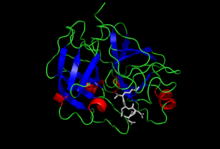| enteropeptidase | |||||||||
|---|---|---|---|---|---|---|---|---|---|
 Crystal structure of Enteropeptidase with an
inhibitor | |||||||||
| Identifiers | |||||||||
| EC no. | 3.4.21.9 | ||||||||
| CAS no. | 9014-74-8 | ||||||||
| Databases | |||||||||
| IntEnz | IntEnz view | ||||||||
| BRENDA | BRENDA entry | ||||||||
| ExPASy | NiceZyme view | ||||||||
| KEGG | KEGG entry | ||||||||
| MetaCyc | metabolic pathway | ||||||||
| PRIAM | profile | ||||||||
| PDB structures | RCSB PDB PDBe PDBsum | ||||||||
| Gene Ontology | AmiGO / QuickGO | ||||||||
| |||||||||
| protease, serine, 7 (enteropeptidase) | |||||||
|---|---|---|---|---|---|---|---|
| Identifiers | |||||||
| Symbol | TMPRSS15 | ||||||
| NCBI gene | 5651 | ||||||
| HGNC | 9490 | ||||||
| OMIM | 606635 | ||||||
| RefSeq | NM_002772 | ||||||
| UniProt | P98073 | ||||||
| Other data | |||||||
| Locus | Chr. 21 q21 | ||||||
| |||||||
Enteropeptidase (also called enterokinase) is an enzyme produced by cells of the duodenum and is involved in digestion in humans and other animals. Enteropeptidase converts trypsinogen (a zymogen) into its active form trypsin, resulting in the subsequent activation of pancreatic digestive enzymes.[1][2] Absence of enteropeptidase results in intestinal digestion impairment.[3]
Enteropeptidase is a serine protease (EC 3.4.21.9) consisting of a disulfide-linked heavy-chain of 82-140 kDa that anchors enterokinase in the intestinal brush border membrane and a light-chain of 35–62 kDa that contains the catalytic subunit.[4] Enteropeptidase is a part of the chymotrypsin-clan of serine proteases, and is structurally similar to these proteins.[5]
- ^ Kunitz M (March 1939). "Formation of trypsin from crystalline trypsinogen by means of enterokinase". J. Gen. Physiol. 22 (4): 429–46. doi:10.1085/jgp.22.4.429. PMC 2141988. PMID 19873112.
- ^ Kiel B (1971). "Trypsin". In Boyer PS (ed.). The Enzymes, 3: Hydrolysis - Peptide Bonds. Amsterdam: Elsevier. pp. 249–75. ISBN 978-0-12-122703-6.
- ^ Light A, Janska H (March 14, 1989). "Enterokinase (enteropeptidase) : comparative aspects". Trends Biochem. Sci. 14 (3): 110–2. doi:10.1016/0968-0004(89)90133-3. PMID 2658218.
- ^ Huang L, Ruan H, Gu W, Xu Z, Cen P, Fan L (2007). "Functional expression and purification of bovine enterokinase light chain in recombinant Escherichia coli". Prep. Biochem. Biotechnol. 37 (3): 205–17. doi:10.1080/10826060701386695. PMID 17516250. S2CID 25387669.
- ^ Rawlings ND, Barrett AJ (February 1993). "Evolutionary families of peptidases". Biochem. J. 290 (1): 205–18. doi:10.1042/bj2900205. PMC 1132403. PMID 8439290.